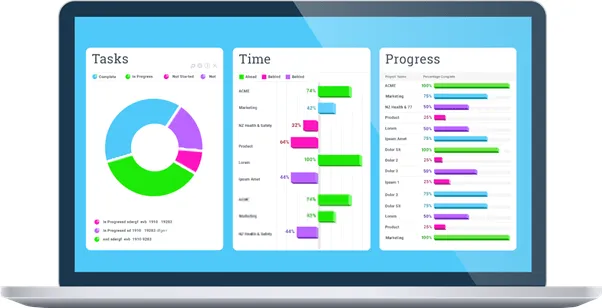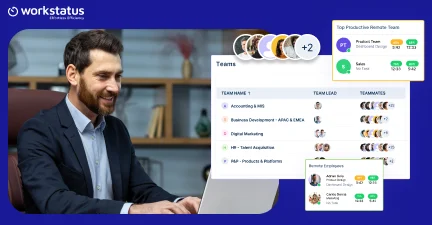Table of Contents
You may have heard the term “remote team” before, but you’re not quite sure how to manage one effectively.
Luckily, plenty of resources are available online to help you with your remote team management needs, especially if you know where to look for the right information.
Today, it’s not uncommon to work remotely with at least one member of your team. Companies are increasingly turning to remote teams to maintain lower expenses and offer flexibility in the workplace.
In fact, according to several surveys and studies, most companies have between 10-50% of their workforce working remotely at any given time. This makes managing remote teams a vital skill to master as an employer or manager in the 21st-century workplace.
Remote work can be highly effective, but there are some things that you need to watch out for and do right if you want your remote teams to be productive and efficient.
If your remote workers are unproductive or inefficient, it could mean that they don’t have the right tools, they are not motivated enough, or their communication channels are not up to par with what you need from them.
However, just because a team works remotely doesn’t mean they don’t need close management. For this reason, you are required to know about the different ways to turn your remote teams into highly productive and efficient workforces, even when they aren’t always in the same office space together.
Based on this fact, we have made a list of top 10 tips that will help you turn your remote teams into highly productive and efficient units that take pride in their work.
You can use these tips to enhance the way you interact with your remote team members so you can build better relationships with the people you depend on to get things done every day.
Let’s get started!
Top 10 Ways You Need To Follow With Your Remote Teams
1) Develop healthy conversations
 This is one of the most important ways in which you can manage a remote team. If you are not actively engaged with your team, they can feel isolated.
This is one of the most important ways in which you can manage a remote team. If you are not actively engaged with your team, they can feel isolated.
A few times a week, have an open, healthy conversation with your employees or others within your company – it will keep them engaged and help them feel like they are part of something larger than themselves.
When having conversations with remote employees on conference calls, make sure you provide positive feedback frequently, so they know how well they are doing.
You may also consider posting photos around their workspace where there might be pictures of their family or other things that remind them of home.
Reminding them that there are people on their team who care about how well they do each day will keep productivity up.
2) Take regular breaks
 While it might seem counterintuitive, taking regular breaks from work can actually make remote workers more productive. Studies have revealed that employees who take short breaks from their jobs report higher job satisfaction, better focus, and more energy.
While it might seem counterintuitive, taking regular breaks from work can actually make remote workers more productive. Studies have revealed that employees who take short breaks from their jobs report higher job satisfaction, better focus, and more energy.
To keep your remote teams fully engaged, you can opt for an online timesheet software and make sure you schedule regular (but reasonable) breaks into their workday. It’s also a great idea to set a weekly check-in call for remote team members. It helps them feel like they’re part of a larger group working toward one goal, even if they’re not in an office. They’ll appreciate being able to talk about what’s going on in their lives as well!
Just don’t use these calls as another thing you demand they do all day; try setting aside just half an hour at a time.
Being remote doesn’t mean remote workers are less than real employees; give them space and time to live their lives outside of work so they can return to it refreshed and ready to perform.
3) Check-in regularly
 Allowing employees to work from home is wonderful, but you have a responsibility to check in regularly as a manager. If an employee’s projects are going well, there may not be much cause for concern. But if something has gone wrong or isn’t on track, that can set off alarms.
Allowing employees to work from home is wonderful, but you have a responsibility to check in regularly as a manager. If an employee’s projects are going well, there may not be much cause for concern. But if something has gone wrong or isn’t on track, that can set off alarms.
To get rid of it, you can install GPS location tracker software and can develop daily meetings with remote workers over video chat at least once a week to observe their progress and know their work location.
You can schedule regular time blocks when you clarify that everyone should be available (at least virtually) during those hours, so team members know they don’t need to take calls with clients or customers during those times (and so management doesn’t need to worry about distractions).
This makes group meetings easier, especially since remote workers often find themselves out of sync with coworkers who share a physical space. Scheduling regular catch-ups also takes some of the pressure off individual one-on-one meetings where you review each person’s status.
4) Set goals together
 When working with a physically separated team, it is crucial to set goals together. Rather than operating as two separate businesses, it’s essential for everyone on both ends of a virtual meeting room to collaborate on what needs to get done and when.
When working with a physically separated team, it is crucial to set goals together. Rather than operating as two separate businesses, it’s essential for everyone on both ends of a virtual meeting room to collaborate on what needs to get done and when.
It’s easy to fall into habitual patterns, but if you operate from a place of explicit understanding about who does what and why—and by when—you are more likely to achieve alignment in your work styles that keep you laser-focused on results.
For example, knowing precisely how much time each person can invest in a given week helps clarify things when trying to schedule meetings. If there’s no expectation policy around availability, you may find yourself frustrated that one teammate always seems busy while another one is constantly idle. Setting weekly availability expectations will ensure everybody stays aligned.
If you really want to keep communication flowing and reduce frustrations caused by misaligned goals, check out Workstatus, Asana, or Basecamp. These tools make sure all parties involved in a project see precisely where things stand at all times.
5) Give feedback as it comes in
 Usually, it’s easier for remote teams to get feedback as it comes in rather than waiting for a quarterly or annual review.
Usually, it’s easier for remote teams to get feedback as it comes in rather than waiting for a quarterly or annual review.
During these informal check-ins, discuss what you liked and didn’t like about their work, how they can improve on tasks they struggled with in the past, and how you might do things differently if you were in their position.
It helps build trust between team members when each knows they will have an open line of communication with their manager anytime they need it. This makes them more likely to ask questions upfront before assignments are due, so they don’t have any last-minute hiccups.
Also, being able to give regular feedback makes both parties feel more invested in projects overall. When employees know exactly where they stand from day-to-day tasks and larger projects, they’re much more likely to stay motivated throughout their time at work.
It also allows managers to make changes quickly if something isn’t working out in an employee’s favor because they will have access to information from all previous rounds of giving feedback.
6) Create opportunities for collaboration

The biggest complaint of remote teams is isolation. To combat isolation, you must find ways for your team members to feel engaged with each other. There are many ways you can do so, such as video chats like Google Hangouts, online forums, online brainstorming sessions, conference calls—but one of my favorites is an app called Skype.
With Skype, you can share documents with multiple users at once, update several people on where you are in a project, and even use video chat during an in-person meeting. It sounds like overkill, but I promise it makes team collaboration much easier! And eventually, it assists you in making a more significant positive impact on your organization.
7) Invest in work management software
 One of our top tips for ensuring your remote teams are productive is investing in remote employee monitoring software.
One of our top tips for ensuring your remote teams are productive is investing in remote employee monitoring software.
Such software will allow you to track how much time each team member is spending on tasks each day, allowing them to get more done and spend less time worrying about face-time with their boss or missing important deadlines. Such GPS tracking software can make remote employees feel like they’re at an office, just by seeing what they’re up to, where they’re clocking in and out from, etc.
It also eliminates any miscommunication that may arise when working remotely.
Software such as Workstatus allows remote managers to see a list of online timesheets – whether it be daily, weekly, or monthly – so that all members of a team are aware of their obligations across projects. Employers will then know exactly who is (and isn’t) doing what as well as when it was completed.
8) Self-Care
 For developing a highly productive team, it’s essential to establish a good work-life balance. The best way to do that is through self-care.
For developing a highly productive team, it’s essential to establish a good work-life balance. The best way to do that is through self-care.
Take some time off each week, even if it’s only a couple of hours. Use your free time wisely by exercising, meditating, or just spending some quality time with family or friends. You will feel refreshed, renewed, and ready for another week of great work.
If you struggle to take care of yourself outside of work, consider tracking your progress on software like WorkStatus. It automatically tracks how much time you spend working so you can understand where you need to take some time out for yourself.
When you have worked too many consecutive days without taking any personal time, WorkStatus sends you an alert letting you know that it might be a good idea to step away from your computer and take a step further towards your health.
A healthy body + healthy mind = high productivity!
Don’t take our word for it – try it out!
9) Increase Everyone’s Morale
 It is essential for your remote teams to feel connected. A good way to do that is through morale boosters.
It is essential for your remote teams to feel connected. A good way to do that is through morale boosters.
The amount of work done in a day doesn’t depend on how much time one spends at their desk; it depends on how motivated they are when they come into work in the morning.
Therefore, providing remote workers with incentive prizes and activities that increase motivation will improve both productivity and efficiency among your teams.
10) Track Results and Celebrate Successes
 These types of incentives can be anything from rewards for completing specific goals to healthy snacks or happy hour events that strengthen team bonds. Get employees excited about coming to work, and you’ll see the improved output.
These types of incentives can be anything from rewards for completing specific goals to healthy snacks or happy hour events that strengthen team bonds. Get employees excited about coming to work, and you’ll see the improved output.
When work gets done within your organization, it’s essential to celebrate successes with your team.
If you have remote teams working on a tight deadline or big project, one of these celebrations could be as simple as allowing employees to log off if they finish early. Try to find something else in which everyone can participate.
If possible, involve everyone who contributed in some way. That way, they get recognized and celebrated together, and they will feel that they are part of something bigger.
Still struggling to manage your remote employees efficiently and feeling confused?
Fortunately, there’s great software that can assist you in every perspective- Workstatus.
WorkStatus is software built for professionals who need assistance in keeping track of their time and expenses. The best part is, it comes equipped with features designed specifically for remote teams!
Here are some tips on how to use WorkStatus as a remote employee monitoring software tool:
-
Easily Track Time Spent on Projects
One of the more difficult tasks when managing remote workers is making sure they complete projects in a timely manner. With WorkStatus, all you have to do is go into your dashboard to see what each employee is working on and how much time has been spent on them. This will enable you to follow up appropriately with any members who aren’t meeting deadlines.
-
One Platform for Every Staff Member
You’ll be hard-pressed to find a better employee management tool than WorkStatus, thanks to its versatility. This software can handle every aspect of managing remote teams from project tracking, time management, billable hours, expenses, invoicing, as well as invoicing.
All you have to do is register your staff in one place and let WorkStatus do all of the work for you! WorkStatus also has a free timesheet app for both Android and iOS users to deliver hassle-free assistance to clients.
If you want to learn more about how to make your remote teams highly productive and efficient, connect with Workstatus today. We offer geofence tracker solutions that will help you keep your entire team connected.
Conclusion
Remote teams have a reputation for being less productive than office-based teams. This is not necessarily true.
In fact, many companies use remote employees with great success. How? By adopting strategies and software that can make any remote team highly productive and efficient.
Overall, there is no single approach to help your employees be more productive; rather, you may build a productive working environment by implementing small and consistent habits.
By providing employees with continuous assistance, encouragement, and feedback, you will see a significant increase in the productivity metric. The strategies outlined above will definitely assist you and your team in acquiring all the new hikes of success.
Hope you enjoyed reading this informative piece.
We’d love to hear about the ways or strategies you use to increase the productivity of your teams. You may leave your suggestions in the comment section below.












